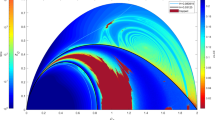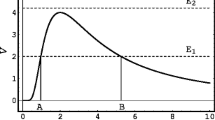Abstract
This paper provides a complete generalization of the classic result that the radius of curvature (ρ) of a charged-particle trajectory confined to the equatorial plane of a magnetic dipole is directly proportional to the cube of the particle’s equatorial distance (ω) from the dipole (i.e. ρ ∝ ω3). Comparable results are derived for the radii of curvature of all possible planar chargedparticle trajectories in an individual static magnetic multipole of arbitrary order m and degree n. Such trajectories arise wherever there exists a plane (or planes) such that the multipole magnetic field is locally perpendicular to this plane (or planes), everywhere apart from possibly at a set of magnetic neutral lines. Therefore planar trajectories exist in the equatorial plane of an axisymmetric (m = 0), or zonal, magnetic multipole, provided n is odd: the radius of curvature varies directly as ωn=2. This result reduces to the classic one in the case of a zonal magnetic dipole (n = 1). Planar trajectories exist in 2m meridional planes in the case of the general tesseral (0 < m < n) magnetic multipole. These meridional planes are defined by the 2m roots of the equation cos[m(φ)–φ mn )] = 0, where φ mn = (1/m) arctan (h mn /g mn ); g mn and h mn denote the spherical harmonic coefficients. Equatorial planar trajectories also exist if (n – m) is odd. The polar axis (θ = O,π) of a tesseral magnetic multipole is a magnetic neutral line if m > I. A further 2m(n – m) neutral lines exist at the intersections of the 2m meridional planes with the (n – m) cones defined by the (n – m) roots of the equation P mn (cos θ) = 0 in the range 0 < 9 < π, where P mn (cos θ) denotes the associated Legendre function. If (n – m) is odd, one of these cones coincides with the equator and the magnetic field is then perpendicular to the equator everywhere apart from the 2m equatorial neutral lines. The radius of curvature of an equatorial trajectory is directly proportional to ωn=2 and inversely proportional to cos[m(φ–φ)]. Since this last expression vanishes at the 2m equatorial neutral ines, the radius of curvature becomes infinitely large as the particle approaches any one of these neutral lines. The radius of curvature of a meridional trajectory is directly proportional to rn+2, where r denotes radial distance from the multiple, and inversely proportional to P mn (cos φ)/sin φ. Hence the radius of curvature becomes infinitely large if the particle approaches the polar magnetic neutral ine (m > 1) or any one of the 2m(n – m) neutral ines located at the intersections of the 2m meridional planes with the (n – m) cones. Illustrative particle trajectories, derived by stepwise numerical integration of the exact equations of particle motion, are pressented for low-degree (n ≤ 3) magnetic multipoles. These computed particle trajectories clearly demonstrate the “non-adiabatic” scattering of charged particles at magnetic neutral lines. Brief comments are made on the different regions of phase space defined by regular and irregular trajectories.
Similar content being viewed by others
Author information
Authors and Affiliations
Additional information
Also Visiting Reader in Physics, University of Sussex, Falmer, Brighton, BN1 9QH, UK
About this article
Cite this article
Willis, D.M., Gardiner, A.R., Davda, V.N. et al. Planar charged-particle trajectories in multipole magnetic fields. Annales Geophysicae 15, 197–210 (1997). https://doi.org/10.1007/s00585-997-0197-9
Received:
Revised:
Accepted:
Issue Date:
DOI: https://doi.org/10.1007/s00585-997-0197-9




